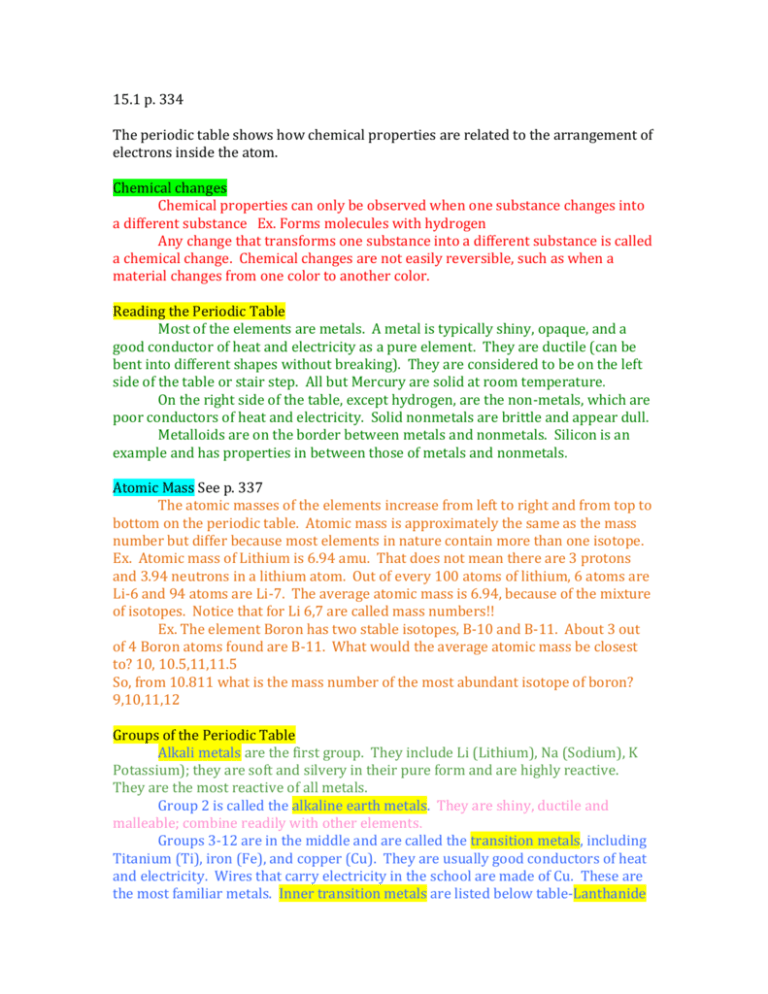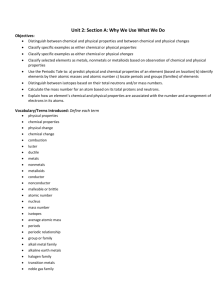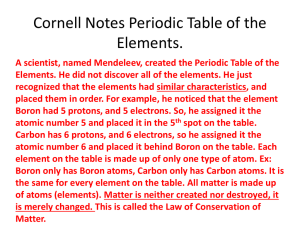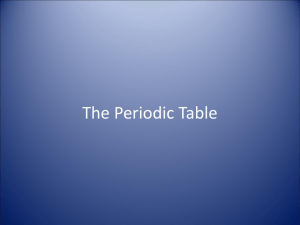15.1 p. 334 The periodic table shows how chemical properties are
advertisement

15.1 p. 334 The periodic table shows how chemical properties are related to the arrangement of electrons inside the atom. Chemical changes Chemical properties can only be observed when one substance changes into a different substance Ex. Forms molecules with hydrogen Any change that transforms one substance into a different substance is called a chemical change. Chemical changes are not easily reversible, such as when a material changes from one color to another color. Reading the Periodic Table Most of the elements are metals. A metal is typically shiny, opaque, and a good conductor of heat and electricity as a pure element. They are ductile (can be bent into different shapes without breaking). They are considered to be on the left side of the table or stair step. All but Mercury are solid at room temperature. On the right side of the table, except hydrogen, are the non-metals, which are poor conductors of heat and electricity. Solid nonmetals are brittle and appear dull. Metalloids are on the border between metals and nonmetals. Silicon is an example and has properties in between those of metals and nonmetals. Atomic Mass See p. 337 The atomic masses of the elements increase from left to right and from top to bottom on the periodic table. Atomic mass is approximately the same as the mass number but differ because most elements in nature contain more than one isotope. Ex. Atomic mass of Lithium is 6.94 amu. That does not mean there are 3 protons and 3.94 neutrons in a lithium atom. Out of every 100 atoms of lithium, 6 atoms are Li-6 and 94 atoms are Li-7. The average atomic mass is 6.94, because of the mixture of isotopes. Notice that for Li 6,7 are called mass numbers!! Ex. The element Boron has two stable isotopes, B-10 and B-11. About 3 out of 4 Boron atoms found are B-11. What would the average atomic mass be closest to? 10, 10.5,11,11.5 So, from 10.811 what is the mass number of the most abundant isotope of boron? 9,10,11,12 Groups of the Periodic Table Alkali metals are the first group. They include Li (Lithium), Na (Sodium), K Potassium); they are soft and silvery in their pure form and are highly reactive. They are the most reactive of all metals. Group 2 is called the alkaline earth metals. They are shiny, ductile and malleable; combine readily with other elements. Groups 3-12 are in the middle and are called the transition metals, including Titanium (Ti), iron (Fe), and copper (Cu). They are usually good conductors of heat and electricity. Wires that carry electricity in the school are made of Cu. These are the most familiar metals. Inner transition metals are listed below table-Lanthanide series-elements with atomic # 58-71 and Actinide series-elements with atomic # 90-103. Nonmetals-elements that are usually gases or brittle solids at room temperature; most can form ionic and covalent compounds-located to the right of the stair step Group 17 are the halogens on the right-hand side of the table. They tend to be toxic in their pure form. Ex. fluorine (F), chlorine (Cl), and bromine (Br). They are very reactive and are rarely found in pure form. Group 18 is the noble gases, including helium (He), neon (Ne), and argon (Ar). They do not naturally form chemical bonds with other atoms and are almost always found in their pure state. Exist as isolated atoms and are all stable because outer energy level is filled. Metalloids-elements that make up stair step; have metallic and non-metallic properties Groups 13-17 include a mixture of metalloids, nonmetals, and metals. Energy levels and the periodic table The periods (rows) of the periodic table correspond to the energy levels in the Bohr model of the atom (Fig. 15.5 p. 339). Ex. Sulfur, element #16, would have how many energy levels completely filled and how many electrons would be left over?








